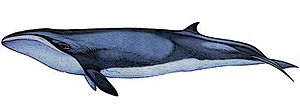Pygmy right whale
| Pygmy right whale | ||||||||||||
|---|---|---|---|---|---|---|---|---|---|---|---|---|

Little right whale ( Caperea marginata ) |
||||||||||||
| Systematics | ||||||||||||
|
||||||||||||
| Scientific name of the subfamily | ||||||||||||
| Neobalaeninae | ||||||||||||
| JE Gray , 1873 | ||||||||||||
| Scientific name of the genus | ||||||||||||
| Caperea | ||||||||||||
| JE Gray , 1864 | ||||||||||||
| Scientific name of the species | ||||||||||||
| Caperea marginata | ||||||||||||
| (JE Gray, 1846) |
The pygmy right whale ( Caperea marginata ) is the smallest of all baleen whales . It is rare and little known. Because of certain similarities, it is sometimes included in the right whale family ; since it deviates too much from these, a family of its own, the Neobalaenidae, was set up for it. Research from 2012 shows that he is the last survivor of the Cetotheriidae , a baleen whale family that was previously thought to be extinct.
features
With a length of no more than 6 m and a weight of up to three tons, the pygmy right whale is unusually small for a baleen whale. The color is black to dark gray. It is connected to the right whales by the oversized head and arched lower jaw. However, there are also striking differences: The pygmy right whale has a dorsal fin and partially recognizable throat furrows, both typical features of the furrow whales . While it seems to mediate between right and furrow whales, there are other characteristics that make it unique among whales. This includes the number of 34 ribs, more than any other whale species.
distribution
The pygmy right whale lives in the temperate cold seas of the southern hemisphere. Because this whale is so rare, there is no definitive clarity about its range. It has been seen in seas near Tasmania , New Zealand , South Africa and the Falkland Islands .
Way of life
Little is known about the way of life. Like the right whale, the pygmy right whale seems to be a slow swimmer who likes to join forces in social associations. In one case a group of eight minke right whales were observed. The food consists of microorganisms such as copepods filtered by the beards .
Others
The pygmy right whale is best known for the carcasses that washed up on the southern coasts of Australia, Tasmania and South Africa in spring and summer. In contrast, it is rarely seen in the open sea. Since it was never hunted, it is believed that this species was never particularly common.
literature
- M. Carwardine: whales and dolphins . Delius Klasing, 2008, ISBN 978-3768824736 (high quality guide)
- Ralf Kiefner: whales and dolphins worldwide . Year Top Special Verlag, 2002 (guide to the magazine "tauchen", very detailed)
- J. Niethammer, F. Krapp (ed.): Handbook of mammals in Europe. Volume 6: marine mammals, Tel 1A: whales and dolphins 1 . AULA-Verlag, Wiesbaden 1994 (very detailed textbook)
- RR Reeves, BS Stewart, PJ Clapham, JA Powell: Sea Mammals of the World. A Complete Guide to Whales, Dolphins, Seals, Sea Lions and Sea Cows. Black, London 2002, ISBN 0-7136-6334-0 (guide with numerous pictures).
- M. Würtz, N. Repetto: Underwater world: Dolphins and Whales . White Star Guides, 2003, ISBN 88-8095-943-3 (identification book)
Individual evidence
- ^ R. Ewan Fordyce, Felix G. Marx: The pygmy right whale Caperea marginata: the last of the cetotheres . In: Proceedings of the Royal Society B: Biological Sciences. 280, 2012, p. 20122645, doi : 10.1098 / rspb.2012.2645 .
- ↑ Wale: A Nerd Survived - Scienceticker, December 19, 2012
Web links
- http://www.cetaceen.de/sp14/
- Caperea marginata in the endangered Red List species the IUCN 2006. Posted by: Cetacean Specialist Group, 1996. Retrieved on 12 May, 2006.
